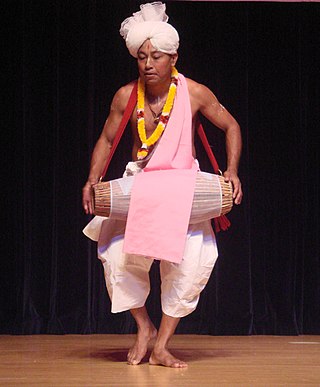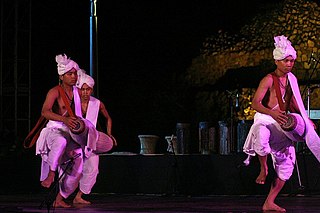
Manipur is a state in northeast India, with the city of Imphal as its capital. It is bounded by the Indian states of Nagaland to the north, Mizoram to the south and Assam to the west. It also borders two regions of Myanmar, Sagaing Region to the east and Chin State to the south. The state covers an area of 22,327 km2 (8,621 sq mi). The official and most widely spoken language is the Meitei language. Native to the Meitei people, it is also used as a lingua franca by smaller communities, who speak a variety of other Tibeto-Burman languages. Manipur has been at the crossroads of Asian economic and cultural exchange for more than 2,500 years. This exchange connects the Indian subcontinent and Central Asia to Southeast Asia, East Asia, Siberia, regions in the Arctic, Micronesia and Polynesia enabling migration of people, cultures and religions.

The Meitei people, Meetei, Manipuri people is an ethnic group native to Manipur. They form the largest and dominant ethnic group of Manipur in Northeast India. They speak the Meitei language, one of the 22 official languages of the Republic of India and the sole official language of Government of Manipur. The Meiteis primarily settled in the Imphal Valley region in modern-day Manipur, though a sizeable population has settled in the other Indian states of Assam, Tripura, Nagaland, Meghalaya, and Mizoram. There is also a notable presence of Meitei people in the neighbouring countries of Myanmar and Bangladesh. The Meitei ethnic group represents about 53% of Manipur's population.

The Pung cholom is a traditional Meitei dance form originated from Manipur, which is the soul of the Manipuri Sankirtana music and the Manipuri classical dance. The Pung cholom is a unique classical dance of Manipur. This dance may be performed by men or women and is usually a prelude to the Ras Lila. In this style, the dancers play the pung while they dance at the same time. Dancers need to be graceful and acrobatic at the same time. They use these acrobatic effects without breaking the rhythm or flow of music. The dance is marked by a gentle rhythm, which gradually builds up to a thunderous climax. Pung cholom borrows elements from the Manipuri martial arts, Thang Ta and Sarit Sarak and also from the traditional Maibi Jagoi.

Manipuri dance, also referred to as the Manipuri Raas Leela, is a jagoi and is one of the major Indian classical dance forms, originating from the state of Manipur. It is one of the greatest cultural achievements of the traditional Vaishnavism adhering Meitei people of Manipur. Owing to the Meitei civilization, the classical dance form, first formally developed by Meitei Hindu king Ching Thang Khomba of the Kingdom of Manipur, is considered to be the highest spiritual expression of the worship of Hindu deity Krishna. Owing to its huge influences on the diverse cultural heritages across the Indian subcontinent, it is recognised by the Sangeet Natak Akademi of the Ministry of Culture of the Government of India as one of the few primary classical dance forms of the Republic of India, and is honoured with the Sangeet Natak Akademi Award for Manipuri annually. It is referred to as the "national dance" during the Armenia-India joint issue of postage stamps, as a part of the Armenia-India international relations.

Sanamahism, also known as Meiteism, or Lainingthouism is an ethnic religion of the Meitei people of Manipur, in Northeast India. It is a polytheistic religion and is named after Lainingthou Sanamahi, one of the most important deities of the Meitei faith. Sanamahi is the eldest son of the supreme god Sidaba Mapu and the supreme goddess Leimarel Sidabi. Traditionally every Meitei household, irrespective of the religion, worships Sanamahi and Leimarel Sidabi. Sanamahism does not have a religious head but has a body, the Maru Loishang, that oversees the main religious activities and governs all affairs of the religion, including the conduct of priest and priestess. The Maru Loishang also acts a court for religious disputes. There are three main departments under the Manu Loishang, namely, the Amaiba Loishang, the Pena Asheiba Loishang, and the Amaibi Loishang. These departments have existed since the reign of King Meidingu Hongnemyoi Khunjao Naothingkhong of Manipur in 662 AD. Sanamahi is the eldest son of the supreme god Sidaba Mapu and the supreme goddess Leimarel Sidabi.

Huiyen Lallong is a traditional Meitei martial art form. It is one of the Indian martial arts, originating from Manipur. In the Meitei language, Huiyen means war while Lallong or Lanlong can mean net, knowledge or art. Huiyen Langlon consists of two main subforms: Thang-Ta and Sarit Sarak. The primary weapons of Huiyen Lallong are the Thang (sword) and Ta (spear). The spear can be used in its non-missile form while up close, or thrown from afar. Other weapons include the shield and the axe. Unarmed combat incorporates hand strikes, kicks, and grappling (Mukna). Because of Manipur's cultural similarity and geographical proximity with Myanmar, huyen langlon is closely related to Burmese bando and banshay.

Lai Haraoba is a traditional Meitei religious festival of ritual dance and musical theatre, celebrated annually in honour of Umang Lais, the forest deities of Sanamahism.

Manipuri Vaishnavism, also known as Meitei Vaishnavism is a regional variant of Gaudiya Vaishnavism with a culture-forming role in the north-eastern Indian state of Manipur.

Yaosang is a festival celebrated in Manipur for five days in spring, starting on the full moon day of the month of Lamda (February–March). Yaosang is indigenous traditions of the Meitei people. It is considered the most important festival in Manipur. But unlike Holi, the celebrations go far beyond just colours.
Elam Endira Devi, is an Indian classical dancer and teacher, known for her expertise and scholarship in the classical dance form of Manipuri, especially in the genres of Lai Haraoba and Raas. The Government of India honored her, in 2014, with the Padma Shri, the fourth highest civilian award, for her services to the field of art and culture.

Pakhangba is a primordial deity, often represented in the form of a dragon, in Meitei mythology and Sanamahism, the indigenous religion of Manipur. He is depicted in the heraldry of Manipur kingdom, which originated in paphal, mythical illustrations of the deity. It is believed that the ancestor of one of the Meitei clans manifested himself as the Pakhangba.
Ningthoukhongjam Khelchandra Singh was an Indian writer, lexicographer and historian, known as the author of Manipuri to Manipuri and English, the first modern general dictionary in Meitei language, which was published in 1964. He was a fellow of the Sahitya Akademi and Sangeet Natak Akademi. The Government of India awarded him the fourth highest civilian honour of Padma Shri in 1987.

Meitei Sankirtan, also known as Meitei Sankirtana or Manipuri Sankirtan or Manipuri Sankirtana, is a Meitei cultural form of performing art involving ritual singing, drumming and dancing performed in the temples and domestic spaces in Manipur in India. Through the performances which exhibit unparalleled religious devotion and energy, the performers narrate the many stories of Krishna often moving the spectators to tears. It is practiced primarily by the Meitei Hindus in Manipur and by the Vaishnava Manipuri population settled in the neighbouring States of Tripura and Assam. "Sankirtana: Ritual singing, drumming and dancing of Manipur" was inscribed on the Representative List of the UNESCO Intangible Cultural Heritage of Humanity during the eighth session of the UNESCO Intergovernmental Committee meeting in Baku, Azerbaijan, held in December 2013.

Imoinu Iratpa or Emoinu Iratpa or Wakching Taranithoini Pānba is a religious festival celebrated by the Meitei people. It is a festival of lights dedicated to the goddess of wealth and prosperity, Imoinu Ahongbi. The festival is celebrated on the twelfth lunar day of Wakching month of Meitei calendar. The festival is celebrated in Manipur, Assam and Tripura states in North Eastern India and observed by some in the neighboring Myanmar. The festival involves sacrifices and prayers to the goddess, followed by various other cultural events.

Umang Lai are deities in Sanamahism who are the local guardians of a neighborhood or particular area. Umang Lais are worshipped only two times in a year. They are the group of sacred groves preserved for the local forest deities, worshipped by the Meitei people, the predominant ethnic groups, since ancient times in the Himalayan state of Manipur. The groves and the deities are worshipped and their pleasing ceremony is always celebrated every year through a music and dance festival called Lai Haraoba. There are 365 Umang Lais in the state, out of which 166 are identified in the valley regions of the state.

Taoroinai is a snake-like dragon in Meitei mythology and Sanamahism, the indigenous religion of Manipur. It lived in the land of the Moon. According to the Shakok Lamlen, the Kangla was constructed over the navel of Taoroinai.

A Helloi or Heloi is a female nature spirit in Meitei mythology, folklore and religion. Hellois are often depicted in the forms of beautiful young women. They are often associated with seduction of men. They are the most powerful among the female spirits. They can cause diseases. The hellois are often known for their charming beauty, ecological balance and seduction of males. Hellois are sometimes seen as evil spirits in the forms of beautiful maidens.
Meitei mythology is a collection of myths, belonging to the religious and cultural traditions of the Meitei people, the predominant ethnic group of Manipur. It is associated with traditional Meitei religion of Sanamahism. Meitei myths explain various natural phenomena, how human civilization developed, and the reasons of many events.

Thangching or Thangjing is a primordial deity in Sanamahism, the indigenous religion of Manipur. He is the ruling deity of the Moirang dynasty. He rules supreme on the banks of the landlocked sea, Loktak lake. He is one of the four cardinal Umang Lais. The guardianship of the south western direction is alluded to Thangjing and the other directions to Koubru, Marjing and Wangbren.

Jagoi refers to the arts of dance in Meitei culture.

















